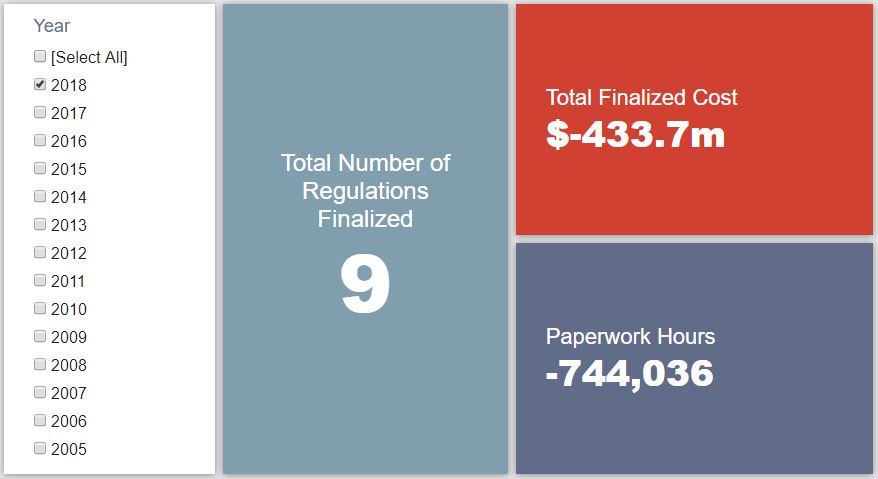Week in Regulation
January 22, 2018
Short Week Brings Minimal Burdens
Already a shorter work-week due to Dr. Martin Luther King Jr. Day, last week saw a particularly limited amount of regulatory activity. In fact, only two out of the four days brought rulemakings with quantifiable cost and paperwork estimates. Between both proposed and final rulemakings, agencies added roughly $4 million in new regulatory costs, but cut paperwork burdens by nearly 75,000 hours. The per capita regulatory burden for 2018 is negative $1.34.
Regulatory Toplines
- New Proposed Rules: 31
- New Final Rules: 50
- 2018 Total Pages of Regulation: 2,705
- 2018 Final Rules: -$433.7 Million
- 2018 Proposed Rules: $49 Million
Tracking Regulatory Modernization
There was at one notable final rule implementing regulatory reforms this week. The Nuclear Regulatory Commission rule would incorporate certain industry code standards into the official regulatory code. This would help streamline some compliance requirements, saving industry roughly $4.5 million and 14,440 hours of paperwork. However, since this action comes from an independent agency is does not count towards the administration’s “regulatory budget” under Executive Order (EO) 13,771 for fiscal year (FY) 2018.
According to American Action Forum (AAF) analysis, since the start of FY 2018 (beginning Oct. 1, 2017), executive agencies have promulgated 14 deregulatory actions with quantified cost savings against 5 regulatory measures that impose costs, under the rubric created by EO 13,771 and the administration’s subsequent guidance document on the matter. These rules combine for a net annual savings of roughly $446.5 million. The administration’s goal for FY 2018 is $687 million in net annual savings.
Click here to view AAF’s examination of the administration’s progress under the “one-in, two-out” executive order through the end of Fiscal Year 2017.
State of Major Obama-Era Initiatives
Based on total lifetime costs of the regulations, the Affordable Care Act has imposed costs of $53 billion in final state and private-sector burdens and 176.9 million annual paperwork hours.
Since passage, the Dodd-Frank financial reform legislation has produced more than 82.9 million final paperwork burden hours and imposed $38.9 billion in direct compliance costs.
Total Burdens
Since January 1, the federal government has published $384.8 million in net costs savings ($433.7 million from final rules) and paperwork burden cuts amounting to 804,220 hours (744,036 from final rules). Click below for the latest Reg Rodeo findings.











